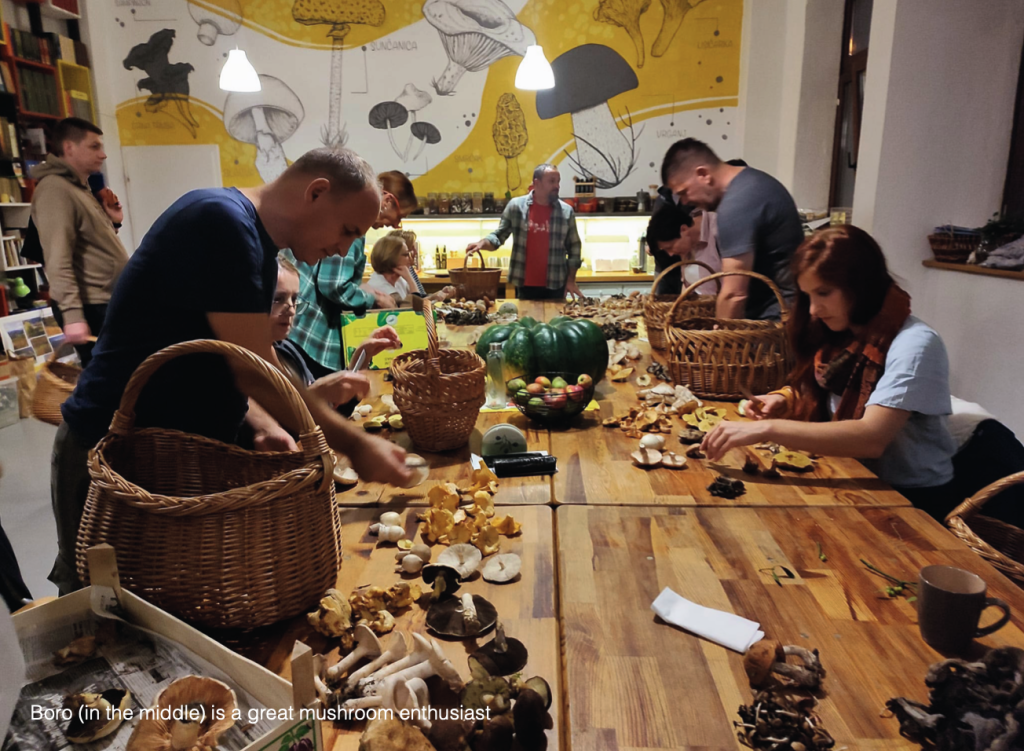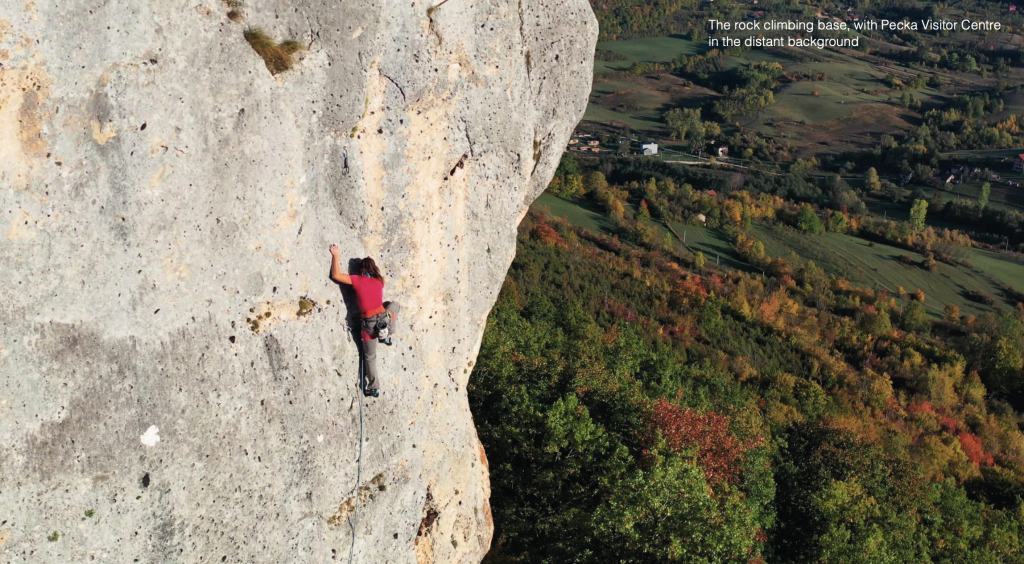Pecka Visitor Centre – making a difference
Bosnia and Herzegovina is a country where the set of real life problems has been mostly replaced by a set of imaginary problems, some of which have never been seen before in the history of the human race, and each and every one of which is perceived as more important than climate change. Not that the rest of the world pays much more attention to the latter, but at least there is some level of organised response to climate change, albeit now probably more concerned with dealing with the consequences, since nobody believes in stopping it anymore. So, if the most advanced nations where climate change is accepted as a fact do little to prepare and even less to stop it, what chances are there in a society where climate change is just a intangible distant threat?
Pecka is a small village, remote even by Bosnian standards. The nearest towns are Šipovo and Mrkonjić Grad, 20 and 30 km away, respectively, and neither of which is exactly a large urban centre. The village is set in a dreamy landscape – calm, beautiful and, like most of the Bosnian countryside, almost deserted. The few remaining people are predominantly old, over 60 or 70 years of age. The school closed because of a lack of children even before the war, back in 1985. The population fell slowly at first and then more quickly, after the war, seemingly leaving Pecka to share the fate of numerous other villages in Bosnia. But instead it has become an example of how just one ini- tiative, just a few people with determination and know-how, can make a huge difference to the fate of the community.
A loose group of environmentalists, at first connected with the common cause of protecting Bosnian rivers, particularly the nearby Sana, succeeded where many state and international programmes failed – to revitalize the village and bring a sense of community. How? Simple. With hard work and honesty.


I talked to one of the people most involved in the project, Boro Marić. We talked over the phone as he walked, I imagine, to the village as the night started to fall. The rhyth- mic sound of his footsteps could be heard in the background, giving the conversation a sense of urgency, but also of steady pace and determination. The result of the conver- sation is the following article.
It all started in 2014, when the abandoned school was leased for a period of ten years to the group now officially formed as an NGO called Greenways. Its goal was the sustainable revitalisation of the community through tourism, food production and envi- ronmental protection. Because of their al- ready long relationship with the area, those involved recognised that the village of Pecka was ideal for their vision. At the very begin- ning they tried to protect the source of the River Sana from the devastation caused by the construction of mini hydropower plant, the bane of many a Bosnian river. But at that time they failed, and the power plant was built some 800 metres downstream from the source. Later, as the group’s influence and reputation grew in the community, they succeed in forcing the government to pro- tect the area further upstream. Greenways is now an important stakeholder in the man- agement of that protected area.
The school, built in 1931, was carefully re- stored by the architect Milan Blagojević. The interventions were kept at a minimum, preserving the important elements of the historic building but also adding contem- porary elements like the decorated façade, and the design proved successful during ten years of use. Solar panels were added later through a crowdfunding campaign, one of the first this kind in Bosnia and Her- zegovina. The building consists of three main rooms, some 65 m2 in area. Dining and communal rooms are located on the ground floor, a workshop and lounge room on the first floor and sleeping quarters in the at- tic. Massive stone walls, some 65 cm thick, make the building energy efficient without the use of thermal insulation.
The transformation of the school in the cen- tre facilitated various activities such as work- shops, educational programmes and a sum- mer outdoor festival that generates most of the visits. To encourage even more visitors, local cliffs that were equipped for climbing quickly became a popular destination.


The centre proved to be so popular that it was not able to accommodate all the visitors interested in staying there. Another effort, a partnership with a private initiative, expanded the accommodation capacities of the centre with the construction of 11 prefab- ricated cottages. These are made of locally sourced wood, designed and built by a lo- cal company. With their varying size they are able to accommodate the needs of various visitors, from couples to larger groups.
After the centre flourished, the organisation expanded activities towards the springs of the River Sana, a natural landscape of significant importance. Indeed, the entire region of Bosanska Krajina is famous for the beauty of its waters, the River Una be- ing the most famous of these. While the area started to attract more visitors, due to the lack of infrastructure there was also a growing problem with litter and fires that were started for barbecues. Greenways partnered with the landscape architect Narcisa Bašić – Gaković, of the studio Context who designed equipment in such a way that in large part it can be constructed by people without advanced building skills. The design is unobtrusive, seemingly effort- less but painstakingly incorporated in the landscape.

The entire project was a mix of contractor work for the more serious con- struction, along with community effort, with the imperfections of the latter a testament to the will of the people to protect their natural environment. It channelled the visitors in such a way that they can enjoy nature and the springs without causing damage. Today, it is estimated that around 20,000 visitors come to the centre each year. The transformation of the centre had a huge impact on the local community, and its success led to cascade of further develop- ments, with around 70 houses having been renovated in the village in the ten years after the centre first opened. Some former resi- dents returned to the village, others plan to rent out the houses, while some just wanted to clean and repair their properties, to make the village a nicer place. The renaissance in Pecka justified further investments, such as a fibre optic internet cable and, most impor- tantly, the reconstruction of a road that leads to the village. The village now has the poten- tial not only to welcome former residents to return there, but also for newcomers to ar- rive – young people who want to settle and work away from the city.
Over the ten years of the project the Visitor Centre functioned not only as a tourist at- traction but as a real village centre, where the local community gathered for impor- tant occasions such as holidays, funerals, and elections. The people involved in the centre built a true relationship with the vil- lagers based on trust, mutual respect and help. The role of the initiative in the revi- talisation of the village proved to be of such an importance that when a local investor started a new open pit mine without proper documentation, those involved in the Pecka Visitor Centre forced the investor and local government to follow the law. Recently, the project expanded its area of influence to the entire region of three municipalities (Ribnik, Šipovo and Mrkonjić Grad) under the name “Dinardica”, and mapped 500 km of bike trails along with all local providers of various services in the tourist sector.
If it was a private initiative the centre would surely already be completely self-sustaina- ble, although the goal is not to transform it into tourist organisation but instead to facili- tate the development of the local community and preservation of natural resources. As such, the whole effort is still dependent on volunteer work and some financial dona- tions, but it remains on a good path to be- coming independent. But even now, it is a prime example of activism as it should be – concerned not with image or empty slogans. If we are to survive as a civilisation, we will survive because of people like this who took the matter into their own hands and worked hard to make something they dreamed of.



The Springs of River Sana, Donja Pecka, Bosnia and Herzegovina, 2022. Landscape architect: Narcisa Bašić Gaković. Viewpoint platform with fire pit in the background, the bridges, the meditation platform and the compost toilet.
A testament to the success of Pecka can be seen on their social media accounts (on Facebook and Instagram), where Boro, a talented photographer, shares photos of their activities. The feed is, to put it mildly, overwhelming. It is a rich, authentic docu- ment, brimming with life. The atmosphere it illustrates is something that every PR agent would dream of. It is that rare glimpse of uto- pia, of people belonging, having purpose, being content with small, earthly things, liv- ing a life removed from everyday concerns. Of course, the reality is much harsher that the images show, but they are not staged or produced in some marketing sweatshop, so it’s possible to suspend one’s disbelief for a moment and say: this is a life as it should be.



Written by:
Boštjan Tadel
SEE magazine #1 /2024
Text and photos: Anna Goncearuc


